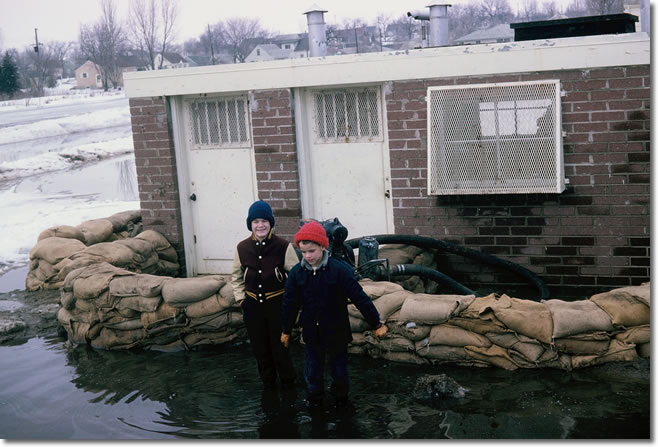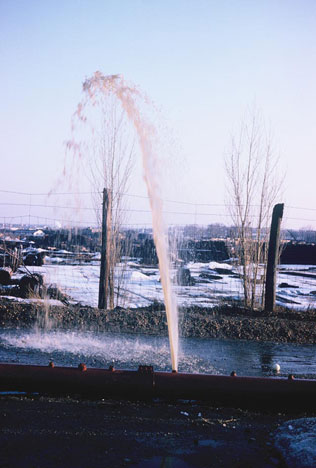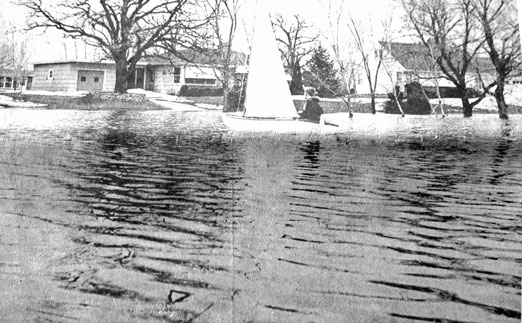1965 was just a horrendous year for weather. It started in March, when it was declared the second coldest March on Record, with temperatures averaging 19.4 degrees – 8 below normal. [The coldest March was in 1899, with an average of 17.1 degrees.] It was also declared the snowiest month in Minnesota history.
On March 17, a blizzard shut down schools for first time since 1950. Although the forecast the previous day called for light snow, 12 inches of snow fell in 24 hours, leaving 20 inches on the ground. Winds were clocked at 30-75 mph, and temperatures plunged below zero in the days after. The Star reported that a minor collision jammed up traffic on Highway 100 for more than an hour, from Cedar Lake Road to 36th Street. The Ambassador Motel on Excelsior Blvd. reported that it was full, with many from Minneapolis. Some called it the worst blizzard in a decade, perhaps in history, in terms of driving conditions. Only one (heart attack while shoveling) fatality was reported. Accounts of the blizzard shared headlines with the March on Selma.
As early as March 25, St. Louis Park engineer Ray Folland expressed concern about flooding if all that snow melted too fast. Specifically vulnerable were the areas without storm sewers, and although the residents had voted them down, an April 6 news account reported Mayor Wolfe ready to put them in “for the good of the residents, whether or not they want them.”
A 672-mile stretch of the Mississippi River experienced the worst flooding in history, lasting for the entire month of April. In St. Paul, the crest was four feet higher than the previous record. On April 14 the flood hit the Cities, flooding local streets and making it possible to paddle Niemeyers’ canoes down Excelsior Blvd. In some places the flooding went on for up to 43 days. 16 people were killed.
Stew Thornley and his brother are shown below at the besieged pumphouse at 32nd and Oregon. “The city ran a pipe up the hill on 32nd Street and beyond Louisiana Avenue to get rid of the water from that pond (which we called the swamp). Then a neighborhood miscreant (not me this time) unscrewed one of the bolts in the pipe and created a geyser. They had to shut down the pumps, wait for the water to stop, and put the bolt back in. Soon after city crews had to tighten every bolt with a wrench so that even a little kid couldn’t undo it by hand.”
“Lake Rhode Island,” in some places 6 feet deep, in an area normally a grassy field. SLP Sun.
The Kilmer neighborhood was hard hit by the floods, with dead frogs washing up into yards around Lake Kilmer. On Saturday, May 1, the Boy Scouts from Oak Knoll Lutheran Church, Jaycees, members of the Lakeview Garden Club, and other neighbors partnered with the City to clean up the area. 100 pine trees were planted on three sides of the lake. Mostly Northern pines, the three to four year old trees were transplanted from a lot at Gorham and First Ave. where a football field was being developed.
On May 3 the City Council authorized the City Manager to apply for Federal financial assistance under the Federal Disaster Act.
On May 5-6 as many as six F-4 tornadoes struck the northern and western portions of the twin cities, killing 16 people an injuring 685. Fridley, Moundsview, Deephaven, Navarre, Blaine and Shoreview were all badly hit. The first funnel cloud was reported at 6:25 pm, moving in from the southwest. Five other twisters followed. WCCO announcers Dick Chapman and Charlie Boone won a Peabody Award for their work keeping viewers informed of what was going on. Tri-County Publications published a special tabloid publication called “Suburbia’s Longest Night” which described the terrors of that night in words and pictures. It was the costliest on record, with the damage coming in at $57 million. It has been called the worst disaster ever to befall the Twin Cities Metropolitan area.



